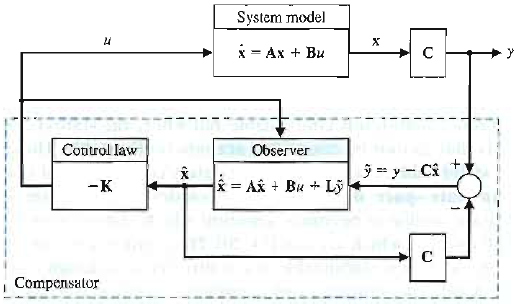
- •Figure 46.1 State variable compensator employing full-state feedback in series with a full-state observer.
- •If the closed-loop input-output transfer function can be represented by a state space equation, see State space (controls),
- •Example 46.1
- •Example 46.2
- •Example 46.3
- •If , then
- •Fig.46.5 Compensator design method using the pole placement method
- •Fig.46.6 Controllability canonical form.
- •In the general case the state variables represented in controllability canonical form may be inaccessible for measurement.
Lecture_4.4
FULL-STATE FEEDBACK CONTROL DESIGN
Ackerman’s formula
1 FULL-STATE FEEDBACK CONTROL DESIGN
In this section, we consider full-state variable feedback to achieve the desired pole
locations of the closed-loop system.

Figure 46.1 State variable compensator employing full-state feedback in series with a full-state observer.
A key question that arises in the design of state variable compensators is whether or not all the poles of the closed-loop system can be arbitrarily placed in the complex plane. Recall that the poles of the closed-loop system are equivalent to the eigenvalues of the system matrix in state variable format. As we shall see, if the system is controllable and observable, then we can accomplish the design objective of placing the poles precisely at the desired locations to meet the performance specifications.
Full-state feedback design commonly relies on pole-placement techniques. It is important to note that a system must be completely controllable and completely observable to allow the
flexibility to place all the closed-loop system poles arbitrarily.
Full state feedback (FSF), or pole placement, is a method employed in feedback control system theory to place the closed-loop poles of a plant in pre-determined locations in the s-plane. Placing poles is desirable because the location of the poles corresponds directly to the eigenvalues of the system, which control the characteristics of the response of the system. The system must be considered controllable in order to implement this method.
If the closed-loop input-output transfer function can be represented by a state space equation, see State space (controls),
![]()
![]()
then the poles of the system are the roots of the characteristic equation given by
![]()
Full
state feedback is utilized by commanding the input vector ![]() .
Consider an input proportional (in the matrix sense) to the state
vector,
.
Consider an input proportional (in the matrix sense) to the state
vector,
![]() .
.
Substituting into the state space equations above,
![]()
![]()
The
roots of the FSF system are given by the characteristic equation, ![]() .
Comparing the terms of this equation with those of the desired
characteristic equation yields the values of the feedback
matrix
.
Comparing the terms of this equation with those of the desired
characteristic equation yields the values of the feedback
matrix ![]() which
force the closed-loop eigenvalues to the pole locations specified by
the desired characteristic equation.
which
force the closed-loop eigenvalues to the pole locations specified by
the desired characteristic equation.
Example 46.1
Consider a control system given by the following state space equations

The uncontrolled system has closed-loop poles at s = − 1 and s = − 2. Suppose, for considerations of the response, we wish the controlled system eigenvalues to be located at
s = − 1 and s = − 5. The desired characteristic equation is then s2 + 6s + 5 = 0.
Following
the procedure given above, ![]() ,
and the FSF controlled system characteristic equation is
,
and the FSF controlled system characteristic equation is
![]() .
.
Upon setting this characteristic equation equal to the desired characteristic equation, we find
![]() .
.
Therefore, setting forces the closed-loop poles to the desired locations, affecting the response as desired.
Determining the gain matrix K is the objective of the full-state feedback design procedure.
The beauty of the state variable design process is that the problem naturally separates into a full-state feedback component and an observer design component.
These two design procedures can occur independently, and in fact, the separation principle provides the proof that this approach is optimal. We will show later that the stability of the closed-loop system is guaranteed if the full-state feedback control law stabilizes the system (under the assumption of access to the complete state) and the observer is stable (the tracking error is asymptotically stable).
Observer design will be discussed in Lecture 4.7.
